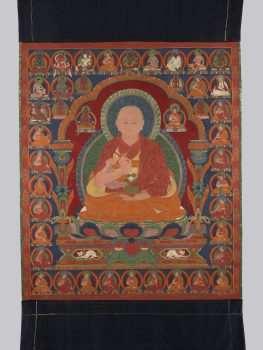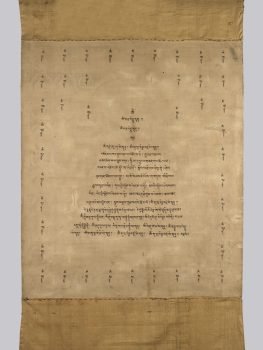Ngor Ewam Choden Monastery, Tsang Province, Central Tibet
1580s-1590s


Ngor Ewam Choden Monastery, Tsang Province, Central Tibet
1580s-1590s


This painting depicts the eleventh abbot of Ngor Monastery, Sanggye Sengge (1504–1569), a great patron of the arts, holding a golden vase of longevity. Signs of venerable age, such as silver stubble of hair and a receding hairline, suggest this is a somewhat realistic painting of the master, in the last years of his life.The painting belongs to a famous series of portraits depicting the Ngor Monastery abbots and teachers of the Path with the Fruit (Lam ‘bras) lineage that was commissioned in the late sixteenth century, the last-known major set of its type in the Nepalese-inspired, or Beri, style. It prominently employs Nepalese decorative scrollwork and the late Beri palate, which features blues and greens. The elegant five-lobed arch around the main figure is supported by ornate pillars, a continuation of Tibet’s earlier Indian-modeled painting tradition.The inscription on the back of this work in the shape of a stupa combines mantras and prayers taken from the Pratimoksha Sutra and is framed by the repeated use of the mantra requesting the essence of the deities to abide in the painting.
The passing down of authentic Buddhist teachings from a teacher to a disciple or student, often in the form of a text in a ritualistic context.
In Buddhism merit is accumulated through engaging in positive actions that lead to positive results, such as better rebirths. Buddhists gain merit by making offerings, donating to those in need, reciting mantras, and other good deeds.
The transmission of teachings from one generation to the next, from teacher to student, traced all the way back to the Buddha without interruption. A complete lineage is essential in Tantric Buddhist practices as it makes the blessings of the teaching more powerful.
Himalayan art includes portraits of legendary and historical humans, including accomplished religious teachers (lamas), the Buddha’s original disciples (arhats), and spiritually accomplished tantric masters (mahasiddhas).
Today, Tibetans primarily inhabit the Tibetan Plateau, situated between the Himalayan mountain range and the Indian subcontinent to the west, Chinese cultural regions to the east, and Mongolian cultural regions to the northeast. During the 7th to 9th century, Tibetan rulers expanded their empire across Central Asia, and established Buddhism as the state religion.
Get the latest news and stories from the Rubin, plus occasional information on how to support our work.